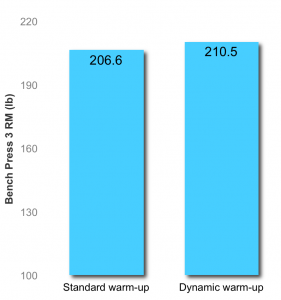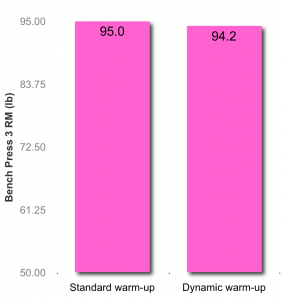A few months ago we started an informal experiment to see how effective different warm-ups were for improving strength on subsequent exercises. In particular, we wanted to know whether dynamic stretching was a useful method when compared to doing only several minutes of moderate cardio.
Before I get to the results, here’s why we studied the effect of dynamic stretching on strength in the first place. It’s simple: nobody else had already studied it. (As they said in the Karate Kid, “Strike first! Strike hard! No mercy!”)
Nowhere in the research literature has the effect of dynamic stretching on bench press strength been examined. On the other hand, there are loads of data showing that static stretching before a workout temporarily decreases strength. (1-3)
Why warm up?
Most of us rush through or completely skip warming up. But a well designed warm-up can benefit your workout in many ways, including:
- Faster contraction and relaxation of both the agonist (primary muscle) and antagonist (biomechanically opposite muscle) (4)
- Faster reaction time (5)
- Improved strength and power (6)
- Lower viscous resistance in muscles (6)
- Improved oxygen delivery (7)
OK, OK, so we know we should be warming up. Jeesh. But if that’s true, then what’s the best way to warm up — at least in terms of improving your strength on exercises that follow the warm-up? That’s what we tried to find out.
Static versus dynamic stretching
To understand this experiment, you need to know the difference between static and dynamic stretching.
Static stretching occurs when you hold a position that stretches a muscle for a given time (usually 15-90 seconds.) Common static stretches are the sitting toe touch or pretty much any stretching you did in gym class. Most yoga poses would also fall into static stretching (with the exception of balance poses).
Dynamic stretching is when you actively move a joint through its range of motion (ROM). Dynamic stretching is also sometimes called mobility drills. Perhaps you’ve heard of the DVDs Magnificent Mobility (by Eric Cressey and Mike Robertson) and Inside-Out (by Mike Robertson and Bill Hartman) — a collection of lower and upper body dynamic stretches/mobility drills, respectively.
Table 1 – Comparing static and dynamic stretching (mobility drills)
| Static stretching | Dynamic stretching | |
| Typical duration/amount of stretch | Hold for 15-90 seconds | 8-15 repetitions or over a given length (say walking lunges over 15 metres) |
| Based on | Muscles | Movements |
| Effect on muscle temperature | No increase in heat from stretching; loss of heat if participant is warm prior to stretching | Increases muscle temperature |
| Muscle(s) activity | Inactive during stretch | Active during stretch |
(Source: Bahrke and Drews, 2008)
Method
We recruited some volunteers from the always-keen PN community. (Thanks, folks!)
16 participants completed the entire study. There were 6 women and 10 men.
| Women | Men | |
| 35.7 +/-4.7 years old 5’3.8” +/-0.8″ tall weighed 140.3 lbs +/-12.3lb |
33.9 +/-3.4 years old 5’9.9” +/-0.9″ tall weighed 188.0 lbs +/-6.1 lb |
In order to participate in the study, the 16 participants had to meet our experimental criteria:
- They had to be already following a weight training program. (In other words, they couldn’t be untrained newbies.)
- They had to be able to measure their bench press strength (3 rep max) three times over a two week period.
- They had to be familiar with the bench press exercise.
- They had to have bench pressed in the previous three months.
They were not eligible to participate if they had any sort of injury, were unfamiliar with proper bench press form, didn’t have a spotter, or intended to change their diet or training program in any significant way during the course of the experiment.
The experiment proceeded as follows.
First, participants tested their 3-repetition maximum (3RM) bench press strength by following a specified protocol that was slightly modified from the Bahrke and Drews 2008 version (see citation 8 below). (Click to download the protocol in PDF.)
Then they were randomly given one of two warm-up protocols. After the first warm-up they tested their 3RM again. Then they were given the other warm-up protocol and tested their 3RM yet again. Each session was separated by at least two days.
Warm-ups
Warm-up 1 was a standard warm-up with no stretching, just a ten-minute jog.
Warm-up 2 was a warm-up with a five-minute jog and three upper body dynamic stretches:
- Wall slides (or what Craig Ballantyne describes as “stick-ups” in this video)
- Side-lying extension-rotations
- Dynamic Blackburns
As the experimenters, we tried to be as sneaky as possible by labeling the warm-ups “Blue” and “White”. That was an attempt to withhold as much information about the warm-ups as we could… but it’s not as though it was a total mystery, since trained people are likely to recognize when they’re doing dynamic stretching.
Results
| Men For the men, there was a modest (2%) but statistically significant increase in 3RM after a warm-up with dynamic stretching compared to just a regular warm up with no additional stretching of any kind. On average the guys lifted 206.6 lbs after the standard warm-up, and 210.5 lbs after the warm up with dynamic stretching. |
Women The women lifted, on average, 95.0 lbs after the standard warm-up and 94.2 lbs after the warm-up with dynamic stretching. So there was no difference between the warm-ups for the women. In fact there was a slight decrease. Why? I’ll get to that later. |
Since this was acute -– a one time thing –- we didn’t bother getting any differences in injuries. However, a few people e-mailed me to say that they felt “looser” with the dynamic warm-up.
Conclusion and discussion
The big question is why in our experiment a warm-up with dynamic stretching helped the guys lift more weight, but didn’t do anything for the women.
I think there are two explanations: the differences in the weight lifted, and possible differences in flexibility.
Say you’re lifting 200 lbs on the bench press and you want to add the smallest amount of weight you possibly can. Chances are, the smallest increment you can add is 5 lbs (2.5lb/side). If you’re lucky, your gym has 1.25 lb plates and you can add a smaller increase of 2.5 lbs. Since the men increased their 3RM by 2% (or about 4 lbs on average) there were some men who increased their bench by 5 lbs or more (the minimum amount available at most gyms) and some who didn’t -– but the average worked out to an increase.
For the women a 2% increase works out to be less than 2 lb. Even if they had a 4% increase (4 lb) they still would be below the 5 lb increment. So the women may have increased their strength in the dynamic warm-up, but the absolute change is too small to measure. Here we see one methodological problem that can arise in experiments: the structure of the experiment (in this case, the available weight progression) can, to some degree, affect the results.
The other possibility is that the women were generally more flexible than the men and the warm-up with dynamic stretching wasn’t as beneficial for the women as it was for the men. It’s certainly possible, but since we didn’t assess flexibility, we can’t say for sure.
Personally, I think it’s very likely that the weight increments were too big to show small changes in the women’s performances, which makes the men’s differences very interesting. It seems with this preliminary data that a warm-up that includes a dynamic stretching increases 3RM on the bench press –- a little.
Thus, in addition to the other benefits of dynamic stretching –- improved flexibility, decrease in injuries –- improved strength might be another.
Give it a try yourself and see what happens. And have a few small plates handy, just in case!
References
Click here to view the information sources referenced in this article.
Learn more
Want to get in the best shape of your life, and stay that way for good? Check out the following 5-day body transformation courses.
The best part? They're totally free.
To check out the free courses, just click one of the links below.






Share